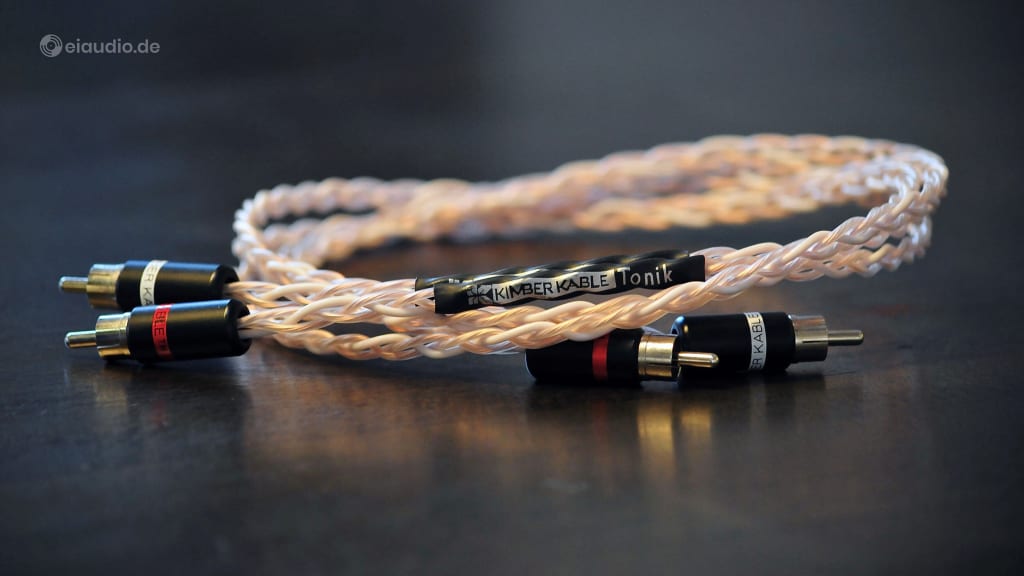Kimber Kable Tonik
07/01/2021
Author: Karsten Hein
Category: Gear & Review
Tag(s): Cables
Kimber’s entry-level interconnect was also my entry ticket to audiophile listening pleasures. With the market for stereo products in decline and a growing demand for home cinema installations in need of much longer cable runs, manufacturers of high-class audio cables had to come up with more affordable solutions to stay in business. Kimber’s Tonik interconnect was especially designed with a slippery and durable outer skin that would make it easy for it to be pulled through holes and installed in walls. While other Kimber cables use wires that consist of strands of seven different gauges, this number was reduced to just four gauges on the Tonik to bring down cost. Other concessions were made in the choice of plugs, e.g. the Tonik’s Ultratike cinch/RCA connector does not have the split centre prong that we typically find on more pricy Kimber products, such as the Timbre or PBJ.
I was attracted to the Tonik by its braided design and affordable price. According to the excellent customer reviews that existed at the time, it offered an exceptional performance for an entry-level interconnect. The novice that I was to the subject of cables, I was absolutely blown away by the immediate improvement in sound, especially in direct comparison with the conventionally shielded cables that I had been familiar with, such as entry-level Sommer or Fadel Art interconnects. I have since been informed that the name Tonik refers to the base tone of a musical scale. But to me it sounded more like ‘Gin and Tonic’, rich in flavour and full of sparkly, bubbly joy.
In true Kimber fashion, the Tonik plays fast, highly dynamic, and informative. Although it is capable of presenting lots of musical detail, it still retains coherence and tonal balance, more so than its in-house competition. The Ultratike’s rhodium-plated contacts seem to help a great deal in supporting the Tonik’s inner momentum. The wires themselves are of ultra-pure copper. Kimber does not specify if OFC or OCC, and it is probably not important, because the cables’ magic trick much rather rests in its tri-braid field geometry, and its construction of wires of various thickness—or VariStrand—as they call it. The PE dielectric is less flexible than that of Kimber’s Timbre or PBJ cables, which makes it a bit more stubborn to handle behind a HiFi rack. Its braided construction serves well to shield it from external interference. Connected to a DAC, CD player or streamer, it is nearly impossible to get it to hum.
Kimber’s braiding technique has a long history. In the 1970s, Ray Kimber was working for a company that installed light and sound gear in some of the first discos. Noticing how long runs of light and sound cables rolled out side by side negatively affected the sound by injecting interference, he found that twisting and braiding these cables together in a specific way would not only protect them from interference but even enhance the sound. Based on this discovery, he founded Kimber Kable, a manufacturer specialising in using braiding techniques. At the time of writing this article, the Utah based Kimber Kable company has 12 employees and supplies audiophile interconnects and speaker cables to music lovers around the globe.
Kimber’s Tonik allows music to flow freely, with zest and harmonic richness. Piano notes and voices sound full and instantly endearing. It sets the stage well, but in comparison with the Timbre lacks some width and depth. The tonal presentation is accurate, however—again in direct comparison with the Timbre—the top-end is not quite as open, and individual notes do not simmer for as long. On Diana Krall’s “Black Crow”, the Tonik presents the music accurately with solid foundation, but the Timbre places the cymbals further away from the speakers and much deeper into the room. The same is true for bass extension. While the Tonik plays a full and compact bass, the Timbre’s bass is lighter, nimbler, and capable of more nuance. With these characteristics in mind, the Tonik is most likely a better companion for Rock, Pop, Hip-hop, etc., whereas Jazz and Classical music lovers would probably be well advised to spend a little bit extra for the next higher level. In the end, it is a question of taste, budget, and how well it blends in with the other components, of course. The Tonik is a superb entry-level cable that allows us to experience sophisticated Kimber sound, or at least 90 percent of it, without having to break the bank. If you do not have any prior experience with braided cables, the Tonik is definitely a good starting point. And—having listened to it again today—I am certainly keeping mine.
Tested on the following setup: CD player: Denon DCD 1420 (on Digital Coax HiVilux Reference); DAC: Cambridge DacMagic 100 (on Kimber Kable Tonik); Preamp: Restek V1 (on Wireworld Luna 7); Power amp: Hafler XL-280; and Tannoy XT8F (bi-wired, on Belden 9497)
Specifications
- Cable lengths: 100cm
- DC loop resistance: 0.055 Ohm/m
- Parallel capacity: 52 Pikofarad/m
- Serial Inductance: 0,772 Microhenry/m
- Characteristic impedance: N.N.
- Handling: directional, hard flexible
- Termination: rhodium-plated, Teflon insulator
- Position tested: CD Player + DAC to preamplifier




